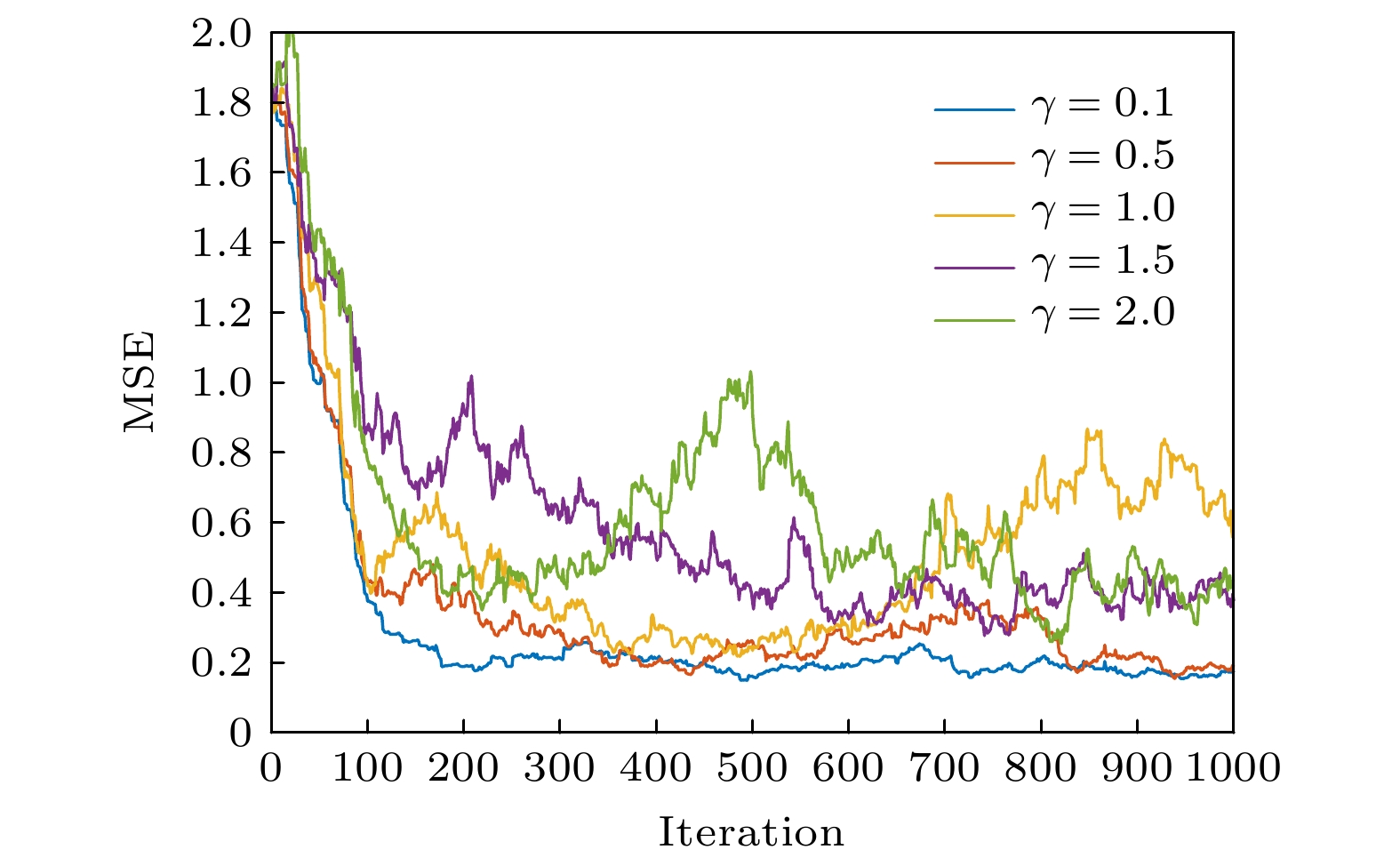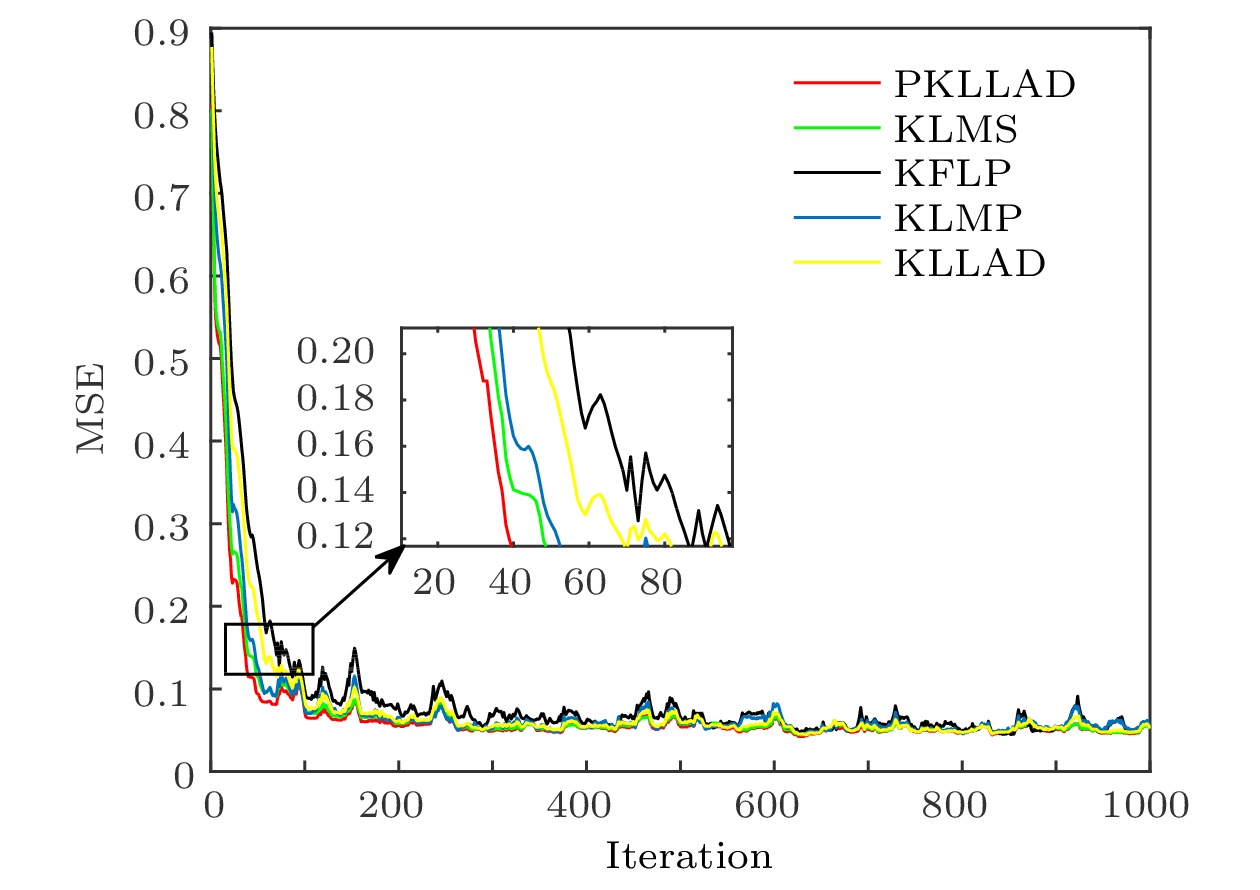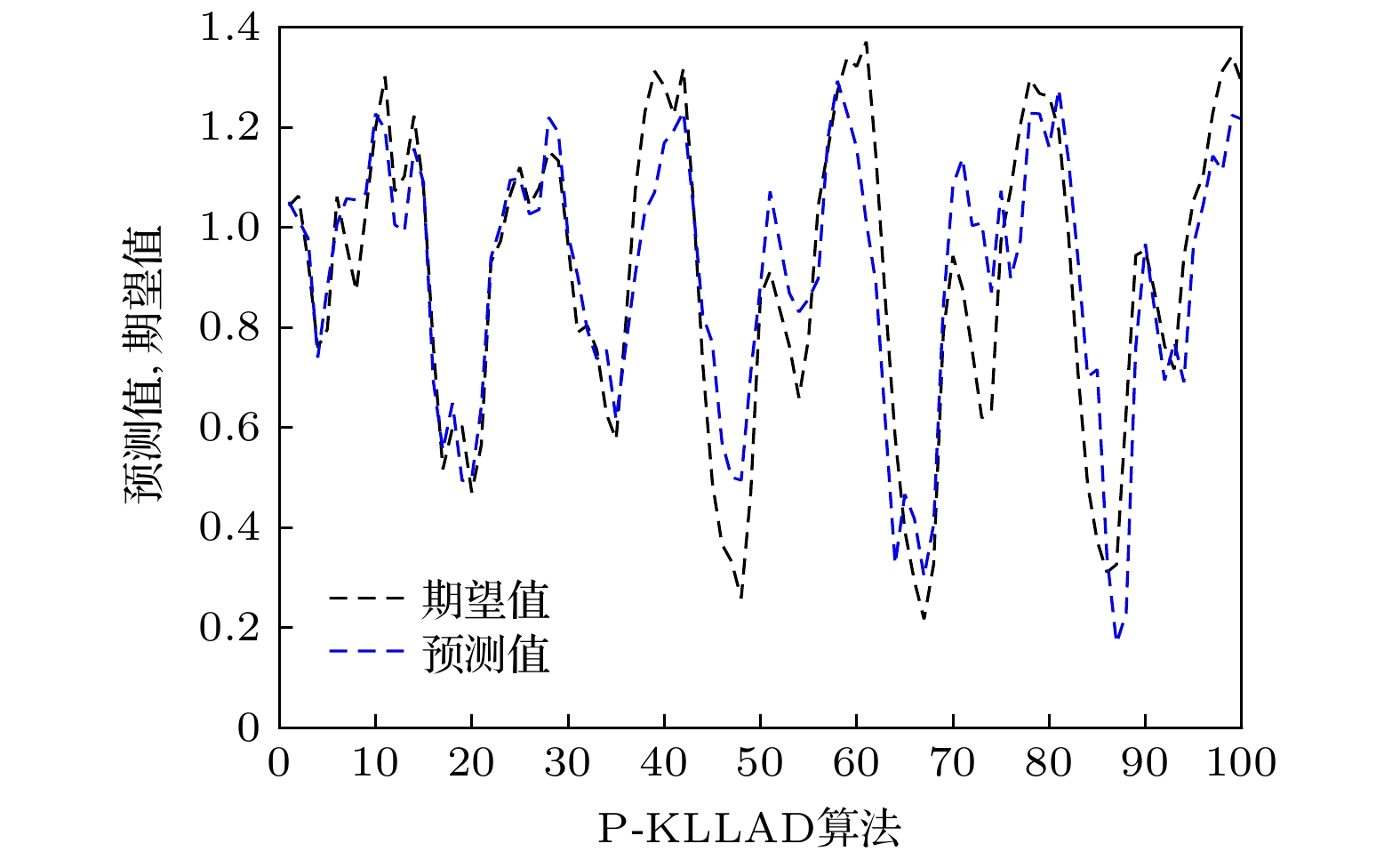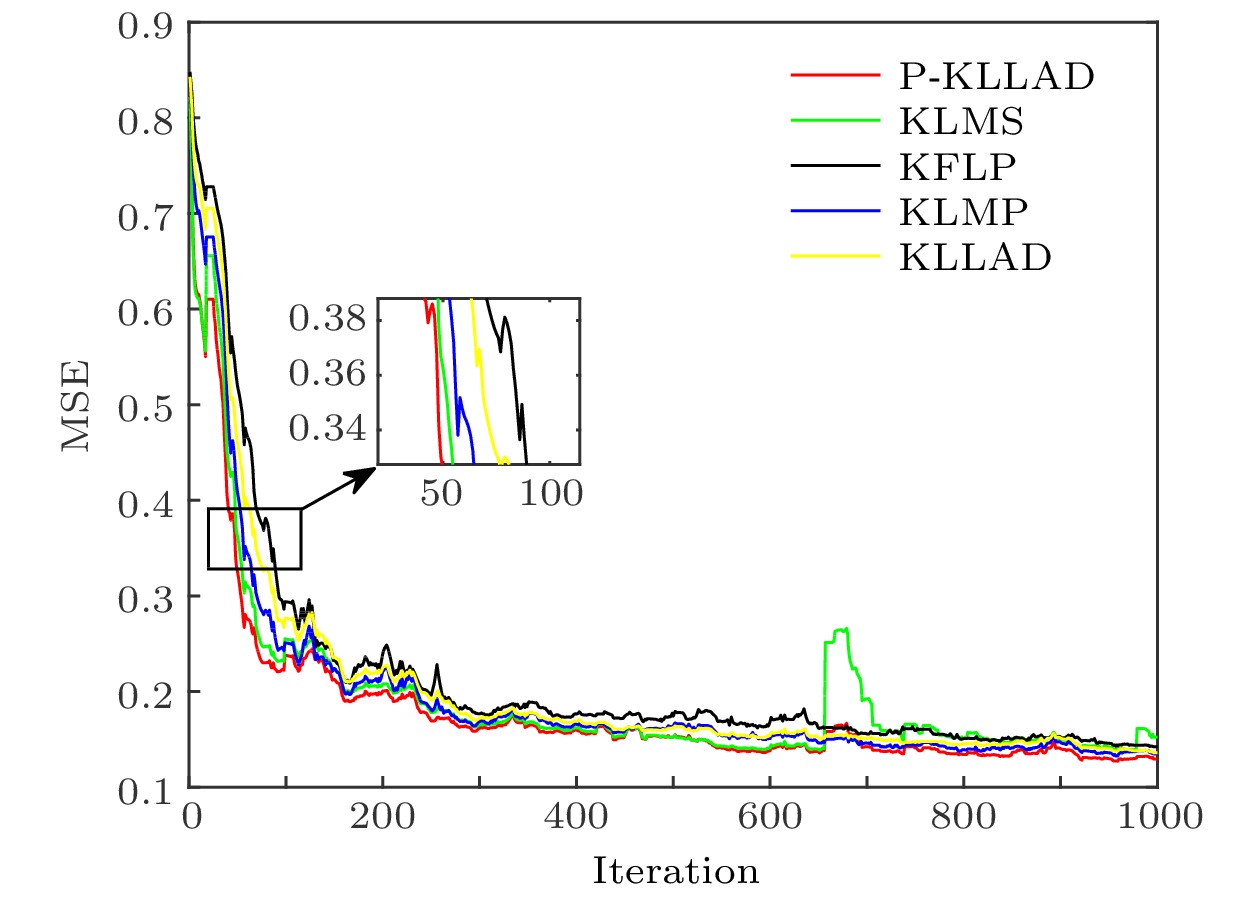-
The kernel adaptive filtering is an efficient and nonlinear approximation method which is developed in reproducing kernel Hilbert space (RKHS). Kernel function is used to map input data from original space to RKHS space, thus solving nonlinear problems is efficient.Impulse noise and non-Gaussian noise exist in the real application environment, and the probability density distribution of these noise characteristics shows a relatively heavy trailing phenomenon in the statistical sense. α stable distribution can be used to model this kind of non-Gaussian noise well. The kernel least mean square(KLMS) algorithms usually perform well in Gaussian noise, but the mean square error criterion only captures the second-order statistics of the error signal, this type of algorithm is very sensitive to outliers, in other words, it lacks robustness in α stable distribution noise. The kernel least logarithm absolute difference(KLLAD) algorithm can deal with outliers well, but it has the problem of slow convergence.In order to further improve the convergence speed of nonlinear adaptive filtering algorithm in α stable distributed noise background, a new kernel least logarithm absolute difference algorithm based on p-norm (P-KLLAD) is presented in this paper. The algorithm combining least logarithm absolute difference algorithm and p norm, on the one hand, the least logarithm difference criteria is ensure the algorithm to have good robustness in α stable distribution noise environment, and on the other hand, add p norm on the absolute value of error.The steepness of the cost function is controlled by p norm and a posititive constant ɑ to improve the convergence speed of the algorithm.The computer simulation results of Mackey-Glass chaotic time series prediction and nonlinear system identification show that this algorithm improves the convergence speed with good robustness,and the convergence speed and robustness better than the kernel least mean square algorithm,the kernel fractional lower power algorithm, the kernel least logarithm absolute difference algorithm and the kernel least mean p-norm algorithm.
-
Keywords:
- α stable distributed noise /
- kernel adaptive filtering algorithm /
- minimum logarithm absolute difference criterion /
- p norm
[1] Liu W F, Príncipe J C, Haykin S 2010 Kernel Adaptive Filtering: A Comprehensive Introduction (Hoboken, NJ, USA: John Wiley & Sons) pp16–32
[2] 田中大, 高宪文, 石彤 2014 物理学报 63 70
 Google Scholar
Google Scholar
Tian Z D, Gao X W, Shi T 2014 Acta Phys. Sin. 63 70
 Google Scholar
Google Scholar
[3] Zhang W, Zhu J 2020 Electronics. 9 940
 Google Scholar
Google Scholar
[4] Pauline S H, Samiappan D, Kumar R, Anand, A, Kar, A 2020 Applied Acoustics. 159 107074
 Google Scholar
Google Scholar
[5] 沈力华, 陈吉红, 曾志刚, 金健 2018 物理学报 67 030501
 Google Scholar
Google Scholar
Shen L H, Chen J H, Ceng Z G, Jin J 2018 Acta Phys. Sin. 67 030501
 Google Scholar
Google Scholar
[6] 王世元, 史春芬, 钱国兵, 王万里 2018 物理学报 67 018401
 Google Scholar
Google Scholar
Wang S Y, Shi C F, Qian G B, Wang W L 2018 Acta Phys. Sin. 67 018401
 Google Scholar
Google Scholar
[7] Wu Q, Li Y, Xue W 2019 Symmetry 11 1067
 Google Scholar
Google Scholar
[8] Wen, F 2013 Electron. Lett. 49 1355
 Google Scholar
Google Scholar
[9] 焦尚彬, 任超, 黄伟超, 梁炎明 2013 物理学报 62 210501
 Google Scholar
Google Scholar
Jiao S B, Ren C, Huang W C, Liang Y M 2013 Acta Phys. Sin. 62 210501
 Google Scholar
Google Scholar
[10] Pelekanakis K, Chitre M 2014 IEEE Wirel. Commun. 13 3183
 Google Scholar
Google Scholar
[11] Aalo V A, Ackie A, Mukasa C 2019 Signal Process. 154 363
 Google Scholar
Google Scholar
[12] Liu W, Pokharel P P, Principe J C 2008 IEEE Trans. Signal Process. 56 543
 Google Scholar
Google Scholar
[13] Seo B 2011 Signal Process. 91 2623
 Google Scholar
Google Scholar
[14] Ma W, Duan J, Man W, Zhao H, Chen B 2017 Eng. Appl. Artif. Intel. 58 101
 Google Scholar
Google Scholar
[15] Wu Z, Shi J, Xie Z, Ma W 2015 Signal Process. 117 11
 Google Scholar
Google Scholar
[16] 赵知劲, 金明明 2017 计算机应用研究 34 3308
 Google Scholar
Google Scholar
Zhao J Z, Jin M M 2017 Appl. Res. Comp. 34 3308
 Google Scholar
Google Scholar
[17] 董庆, 林云 2019 计算机科学 046 80
 Google Scholar
Google Scholar
Dong Q, Lin Y 2019 Comp. Sci. 046 80
 Google Scholar
Google Scholar
[18] 火元莲, 王丹凤, 龙小强, 连培君, 齐永锋 2021 物理学报 70 415
 Google Scholar
Google Scholar
Huo Y L, Wang D F, Long X Q, Lian P J, Qi Y F 2021 Acta Phys. Sin. 70 415
 Google Scholar
Google Scholar
[19] 林云, 雷洋, 曾俊俊 2016 电子技术应用 42 78
 Google Scholar
Google Scholar
Lin Y, Lei Y, Zeng J J 2016 Appl Electron. Tech. 42 78
 Google Scholar
Google Scholar
[20] Sayin M O, Vanli N D, Kozat S S 2014 IEEE Trans. Signal Process. 62 4411
 Google Scholar
Google Scholar
-
表 1 P-KLLAD算法
Table 1. P-KLLAD algorithm.
P-KLLAD算法 初始化: 选择合适的参数a, p和核宽h,
${a_1}(1) = \eta \dfrac{ {ap{ {\left| {d\left( 1 \right)} \right|}^{2 p - 1} } } }{ {1{ { + } }{ {\left| {d\left( 1 \right)} \right|}^p} } }{ {\rm{sgn} } } \left( {d\left( 1 \right)} \right)$更新: 每获得一对$ \left\{ {\boldsymbol u({ {i} }), d(i)} \right\} $, 计算输出值:
$ {f_{i - 1} }(\boldsymbol u({\rm{i} })) = \eta \displaystyle \sum\limits_{j = 1}^{i - 1} { {a_j}({\rm{i} } - 1)\kappa (\boldsymbol u({\rm{i} }), \boldsymbol u(j)} ) $计算误差: $ e(i) = d(i) - {f_{i - 1} }(\boldsymbol u({\rm{i} })) $ 更新系数: ${a_i}(i) = \eta \dfrac{ {ap{ {\left| {e\left( i \right)} \right|}^{2 p - 1} } } }{ {1{ { + } }{ {\left| {e\left( i \right)} \right|}^p} } }{ {\rm{sgn} } } \left( {e\left( i \right)} \right)$ 表 2 算法的复杂度对比
Table 2. Complexity of the algorithm.
算法名称 乘法或
除法加法或
减法指数
运算符号
函数分数幂
运算KLMS $ 3 i - 1 $ $ 2 i - 1 $ $ i - 1 $ — — KFLP $ 3 i - 2 $ $ 2 i - 1 $ $ i - 1 $ — — KLMP $ 3 i - 2 $ $ 2 i - 1 $ $ i - 1 $ 1 1 KLLAD $ 3 i + 1 $ $ 2 i - 1 $ $ i - 1 $ — — P-KLLAD $ 3 i + 1 $ $ 2 i - 1 $ $ i - 1 $ 1 2 表 3 各种算法的参数设定
Table 3. Parameter setting of various algorithms.
KLMS KLMP KFLP KLLAD P-KLLAD η 0.1 0.1 0.1 0.1 0.1 p 1.2 0.9 1.1 a 5 3 表 4 均值 ± 标准偏差
Table 4. Mean ± standard deviation.
算法 MSE KLMS $ {{0}}{{.1952}} \pm {{0}}{{.1909}} $ KLMP $ {{0}}{{.1921}} \pm {{0}}{{.01339}} $ KFLP $ {{0}}{{.2311}} \pm {{0}}{{.02468}} $ KLLAD $ {{0}}{{.1794}} \pm {{0}}{{.0209}} $ P-KLLAD $ {{0}}{{.1792}} \pm {{0}}{{.0130}} $ 表 5 均值 ± 标准偏差
Table 5. Mean ± standard deviation.
算法 MSE KLMS $ { {0} }{ {.0467} } \pm { {0} }{ {.0058} } $ KLMP $ { {0} }{ {.0485} } \pm { {0} }{ {.0086} } $ KFLP $ { {0} }{ {.0507} } \pm { {0} }{ {.0118} } $ KLLAD $ { {0} }{ {.0492} } \pm { {0} }{ {.0354} } $ P-KLLAD $ { {0} }{ {.0423} } \pm { {0} }{ {.0050} } $ -
[1] Liu W F, Príncipe J C, Haykin S 2010 Kernel Adaptive Filtering: A Comprehensive Introduction (Hoboken, NJ, USA: John Wiley & Sons) pp16–32
[2] 田中大, 高宪文, 石彤 2014 物理学报 63 70
 Google Scholar
Google Scholar
Tian Z D, Gao X W, Shi T 2014 Acta Phys. Sin. 63 70
 Google Scholar
Google Scholar
[3] Zhang W, Zhu J 2020 Electronics. 9 940
 Google Scholar
Google Scholar
[4] Pauline S H, Samiappan D, Kumar R, Anand, A, Kar, A 2020 Applied Acoustics. 159 107074
 Google Scholar
Google Scholar
[5] 沈力华, 陈吉红, 曾志刚, 金健 2018 物理学报 67 030501
 Google Scholar
Google Scholar
Shen L H, Chen J H, Ceng Z G, Jin J 2018 Acta Phys. Sin. 67 030501
 Google Scholar
Google Scholar
[6] 王世元, 史春芬, 钱国兵, 王万里 2018 物理学报 67 018401
 Google Scholar
Google Scholar
Wang S Y, Shi C F, Qian G B, Wang W L 2018 Acta Phys. Sin. 67 018401
 Google Scholar
Google Scholar
[7] Wu Q, Li Y, Xue W 2019 Symmetry 11 1067
 Google Scholar
Google Scholar
[8] Wen, F 2013 Electron. Lett. 49 1355
 Google Scholar
Google Scholar
[9] 焦尚彬, 任超, 黄伟超, 梁炎明 2013 物理学报 62 210501
 Google Scholar
Google Scholar
Jiao S B, Ren C, Huang W C, Liang Y M 2013 Acta Phys. Sin. 62 210501
 Google Scholar
Google Scholar
[10] Pelekanakis K, Chitre M 2014 IEEE Wirel. Commun. 13 3183
 Google Scholar
Google Scholar
[11] Aalo V A, Ackie A, Mukasa C 2019 Signal Process. 154 363
 Google Scholar
Google Scholar
[12] Liu W, Pokharel P P, Principe J C 2008 IEEE Trans. Signal Process. 56 543
 Google Scholar
Google Scholar
[13] Seo B 2011 Signal Process. 91 2623
 Google Scholar
Google Scholar
[14] Ma W, Duan J, Man W, Zhao H, Chen B 2017 Eng. Appl. Artif. Intel. 58 101
 Google Scholar
Google Scholar
[15] Wu Z, Shi J, Xie Z, Ma W 2015 Signal Process. 117 11
 Google Scholar
Google Scholar
[16] 赵知劲, 金明明 2017 计算机应用研究 34 3308
 Google Scholar
Google Scholar
Zhao J Z, Jin M M 2017 Appl. Res. Comp. 34 3308
 Google Scholar
Google Scholar
[17] 董庆, 林云 2019 计算机科学 046 80
 Google Scholar
Google Scholar
Dong Q, Lin Y 2019 Comp. Sci. 046 80
 Google Scholar
Google Scholar
[18] 火元莲, 王丹凤, 龙小强, 连培君, 齐永锋 2021 物理学报 70 415
 Google Scholar
Google Scholar
Huo Y L, Wang D F, Long X Q, Lian P J, Qi Y F 2021 Acta Phys. Sin. 70 415
 Google Scholar
Google Scholar
[19] 林云, 雷洋, 曾俊俊 2016 电子技术应用 42 78
 Google Scholar
Google Scholar
Lin Y, Lei Y, Zeng J J 2016 Appl Electron. Tech. 42 78
 Google Scholar
Google Scholar
[20] Sayin M O, Vanli N D, Kozat S S 2014 IEEE Trans. Signal Process. 62 4411
 Google Scholar
Google Scholar
Catalog
Metrics
- Abstract views: 6725
- PDF Downloads: 69
- Cited By: 0














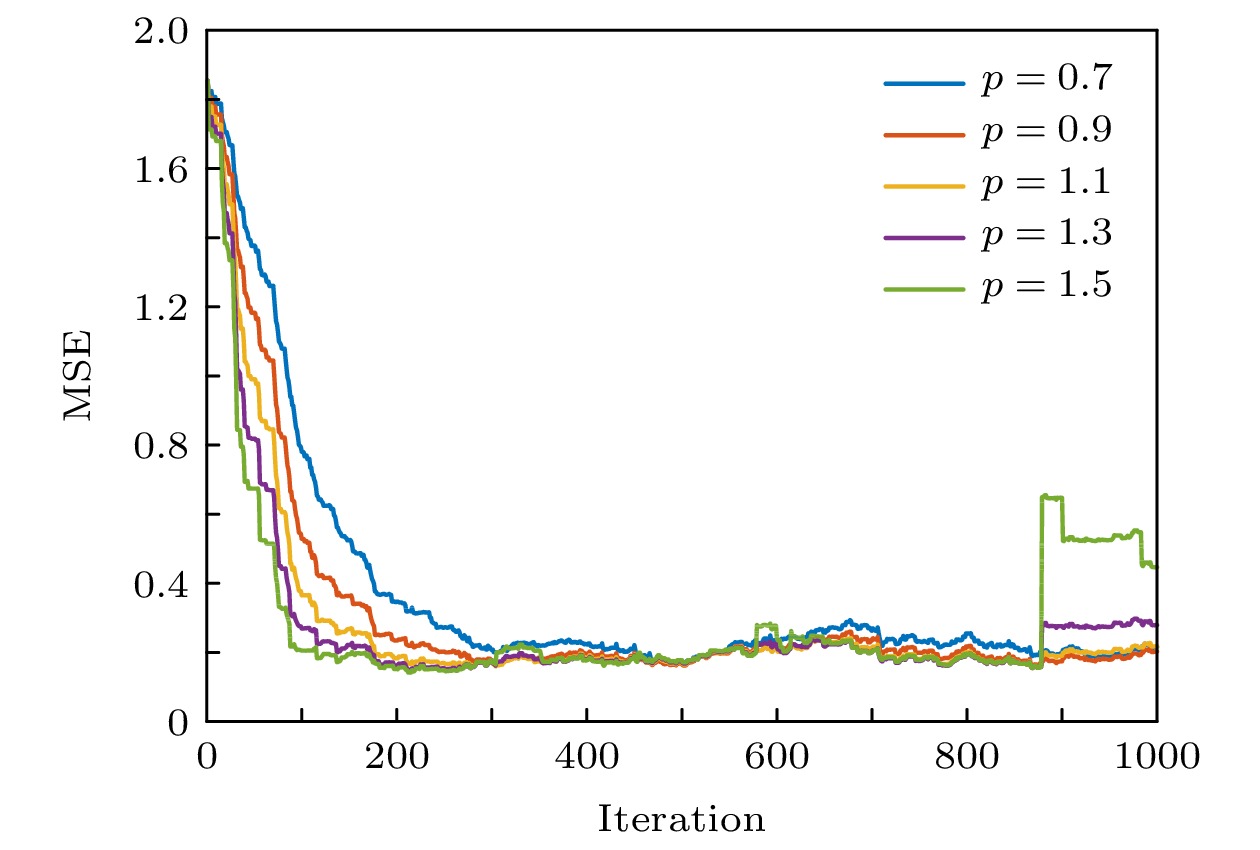
 DownLoad:
DownLoad:


